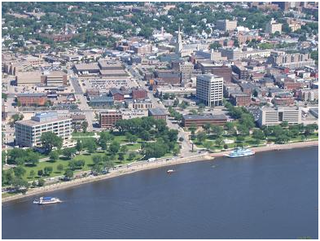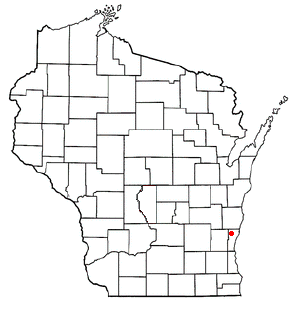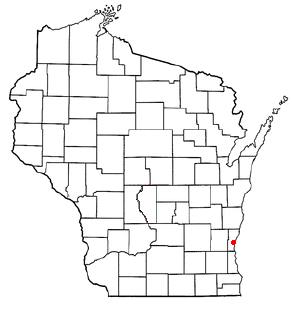History
The first settlers came to the area in 1835, including some from Granville, New York, [1] who gave the area its name. On January 13, 1840, the Town of Granville was created by the territorial legislature, encompassing a western portion of the Town of Milwaukee. As of the 1840 census, the population of the Town of Granville was 225. [2]
Granville was settled in the late 1830s and 1840s by a group of Pennsylvania Dutch (German) immigrants who had formerly lived in Telford, Pennsylvania, led by Samuel Wambold. They dedicated a church building, the German Evangelical Lutheran and Reformed Church of Granville Township, on June 17, 1849. (The church is currently known as Salem Evangelical Lutheran Church.) On May 26, 1850 the current pastor, Wilhelm Wrede, hosted a meeting of local Lutheran ministers at the church: this group later became the Wisconsin Evangelical Lutheran Synod. [3]
The area around Good Hope Road and 43rd Street was known as East Granville, and was home to the East Granville Cemetery which was started in the 1840s. The cemetery was moved by Brown Deer in 1969 to widen existing roads. [4]
The area around Mill Road and 107th Street was known as West Granville, and was home to the German Lutherans mentioned above. The area was also home to the West Granville Cemetery which was started in 1853. [5]
Separation, annexation, and consolidation with Milwaukee
The northeastern corner of the town was known as Brown Deer, and eventually became the incorporated Village of Brown Deer on January 20, 1955, after a court battle between area residents and the city of Milwaukee (which hoped to annex the area). The remainder was consolidated with the City of Milwaukee after referendums held in both jurisdictions on April 3, 1956 approved the move.
However, on July 12, 1956, the Town Board of Granville passed a motion to repeal the ordinance under which the April referendum had been held, and the matter ended up in the hands of the Wisconsin Supreme Court, which finally ruled that the consolidation had been lawfully approved and the Town of Granville had ceased to exist. [6] [7]
The final details of which portions were to go to Milwaukee and which to Brown Deer were not finally put to rest until April 1962, with one parcel of a quarter of a square miles going to Brown Deer. [8] [9]

Milwaukee, officially the City of Milwaukee, is the most populous city in the U.S. state of Wisconsin and the county seat of Milwaukee County. With a population of 577,222 at the 2020 census, Milwaukee is the 31st largest city in the United States, the fifth-largest city in the Midwestern United States, and the second largest city on Lake Michigan's shore behind Chicago.

Ozaukee County is a county in the U.S. state of Wisconsin. As of the 2020 census, the population was 91,503. Its county seat is Port Washington, making it one of three Wisconsin counties on Lake Michigan not to have a county seat with the same name. Ozaukee County is included in the Milwaukee–Waukesha–West Allis, WI Metropolitan Statistical Area.

Dane County is a county in the U.S. state of Wisconsin. As of the 2020 census, the population was 561,504, making it the second-most populous county in Wisconsin. The county seat is Madison, which is also the state capital.

La Crosse is a city in the U.S. state of Wisconsin and the county seat of La Crosse County. Positioned alongside the Mississippi River, La Crosse is the largest city on Wisconsin's western border. La Crosse's population as of the 2020 census was 52,680. The city forms the core of and is the principal city in the La Crosse–Onalaska Metropolitan Area, which includes all of La Crosse County and Houston County, Minnesota, with a population of 139,627.

Brown Deer is a village in Milwaukee County, Wisconsin, United States. As a suburb of Milwaukee, it is part of the Milwaukee metropolitan area. The population was 12,507 at the 2020 census.

Mequon is the largest city in Ozaukee County, in the U.S. state of Wisconsin, and the third-largest city in Wisconsin by land area. Located on Lake Michigan's western shore with significant commercial developments along Interstate 43, the community is a suburb in the Milwaukee metropolitan area. Despite being an incorporated city, approximately half of Mequon's land is undeveloped and agriculture plays a significant role in the local economy. At the time of the 2010 census the population was 23,132.

Thiensville is a village in Ozaukee County, Wisconsin, United States. Located on the west bank of a bend in the Milwaukee River, the community is bordered on all sides by the City of Mequon and is a suburb in the Milwaukee metropolitan area. The population was 3,235 at the 2010 census.

Eau Claire is a city mostly located in Eau Claire County, Wisconsin, being the county seat of Eau Claire County, but with a small portion in Chippewa County, Wisconsin. The city had a population of 69,421 in 2020, making it the state's eighth-largest city. Eau Claire is the principal city of the Eau Claire, Wisconsin Metropolitan Statistical Area, locally known as the Chippewa Valley, and is also part of the larger Eau Claire-Menomonie Combined Statistical Area.

Cedarburg is a city in Ozaukee County, Wisconsin, United States. Located about 20 miles (32 km) north of Milwaukee and in close proximity to Interstate 43, it is a suburban community in the Milwaukee metropolitan area. The city incorporated in 1885, and at the time of the 2010 census the population was 11,412.

Fredonia is a town in Ozaukee County, Wisconsin, United States. The population was 2,903 at the 2000 census. The Village of Fredonia is surrounded by the town. The unincorporated communities of Little Kohler and Waubeka are also located in the town.

Grafton is a town in Ozaukee County, Wisconsin, United States, and is in the Milwaukee metropolitan area. The town was created in 1846 and at the time of the 2010 census had a population of 4,053.

Grafton is a village in Ozaukee County, Wisconsin, United States. Located about 20 miles (32 km) north of Milwaukee and in close proximity to Interstate 43, it is a suburban community in the Milwaukee metropolitan area. The village incorporated in 1896, and at the time of the 2010 census the population was 11,459.

Port Washington is the county seat of Ozaukee County in the U.S. state of Wisconsin. Located on Lake Michigan's western shore east of Interstate 43, the community is a suburb in the Milwaukee metropolitan area 27 miles north of the City of Milwaukee. The city's artificial harbor at the mouth of Sauk Creek was dredged in the 1870s and was a commercial port until the early 2000s. The population was 11,250 at the 2010 census.

Jackson is a town in Washington County, Wisconsin, United States. The population was 3,516 at the 2000 census. The Village of Jackson is located partially within the town. The unincorporated community of Kirchhayn is also located in the town.

Oconomowoc is a city in Waukesha County, Wisconsin, United States. The name was derived from Coo-no-mo-wauk, the Potawatomi term for "waterfall." The population was 15,712 at the 2010 census. The city is partially adjacent to the Town of Oconomowoc and near the village of Oconomowoc Lake, Wisconsin.

Pewaukee is a city in Waukesha County, Wisconsin. The population was 13,195 at the 2010 census. The Village of Pewaukee, which was incorporated out of the town before it incorporated as a city, is surrounded by the city.

Berlin is a city in Green Lake and Waushara counties in the U.S. state of Wisconsin. The population was 5,524 at the 2010 census. Of this, 5,435 were in Green Lake County, and only 89 were in Waushara County. The city is located mostly within the Town of Berlin in Green Lake County, with a small portion extending into the Town of Aurora in Waushara County.
The Town of Milwaukee was a town in Milwaukee County, Wisconsin, United States, created on March 17, 1835. A number of Milwaukee County municipalities, beginning with the City of Milwaukee, were created out of portions of it. After the last portions of the town were annexed, it officially ceased to exist in 1955.
Root Creek was a hamlet in Sections 21-22 and 27-28 of the Town of Greenfield in Milwaukee County, Wisconsin, United States, on the Milwaukee-Janesville plank road, at what is now roughly the intersection of that thoroughfare and 68th Street. The body of water after which it was named is nowadays referred to as the Root River.
Frederick W. Velguth was an architect in Milwaukee, Wisconsin. Several buildings he designed are listed on the National Register of Historic Places.



















